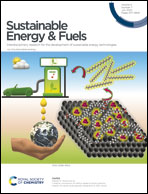Metal–organic-frameworks on 3D-printed electrodes: in situ electrochemical transformation towards the oxygen evolution reaction†
Abstract
Metal–organic framework (MOF) derived materials are important alternatives for electrochemical energy storage and conversion, due to their highly large surface area, abundant active sites, and diversity in composition and structure. In this work, a controllable electrochemical transformation of ZIF-67 into active porous metal oxides is employed for the oxygen evolution reaction (OER). ZIF-67 is directly coated onto the surface of three-dimensional (3D) printed titanium (Ti) electrodes using a step-by-step in situ growth and then converted into cobalt oxide (Co3O4) by electrochemical cycling, designated as ZIF-67/Ti-E electrode. Raman spectroscopy, scanning electron microscopy (SEM), and cyclic voltammetry (CV) have been used to verify the electrochemical transformation from octahedral ZIF-67 to thin sheet-shaped Co3O4. This large-surface-area Co3O4, as well as the existence of CoIV species right before water oxidation, plays a critical role in enhanced OER performance under alkaline electrolysis conditions. The optimized ZIF-67/Ti-E electrode has demonstrated a better OER performance with a low overpotential of 360 mV at a current density of 10 mA cm−2 and excellent durability, compared with its counterparts produced by the widely popular calcination method. Our method provides a simple in situ, fast, mild, and energy-efficient approach to employ MOF-derived materials as promising OER catalysts using scaled-up 3D-printed electrodes.



 Please wait while we load your content...
Please wait while we load your content...